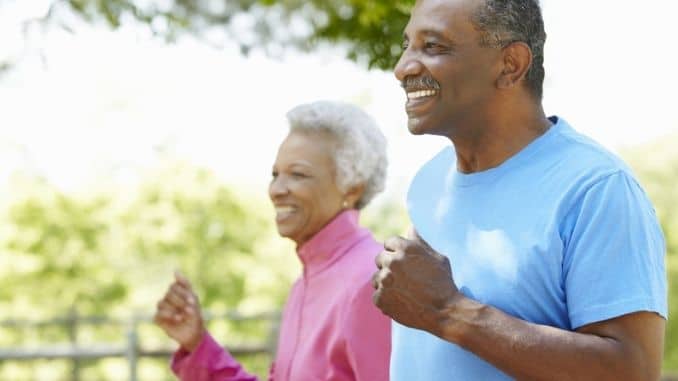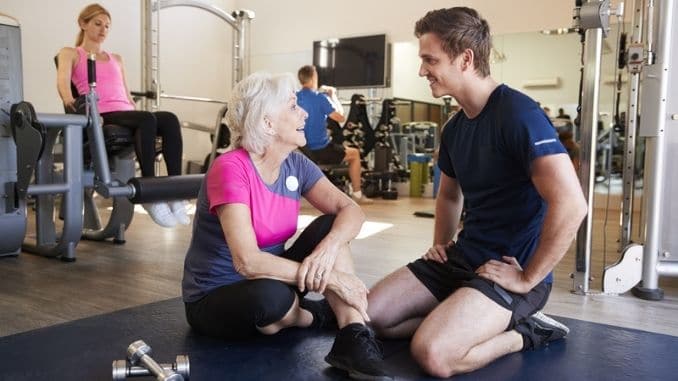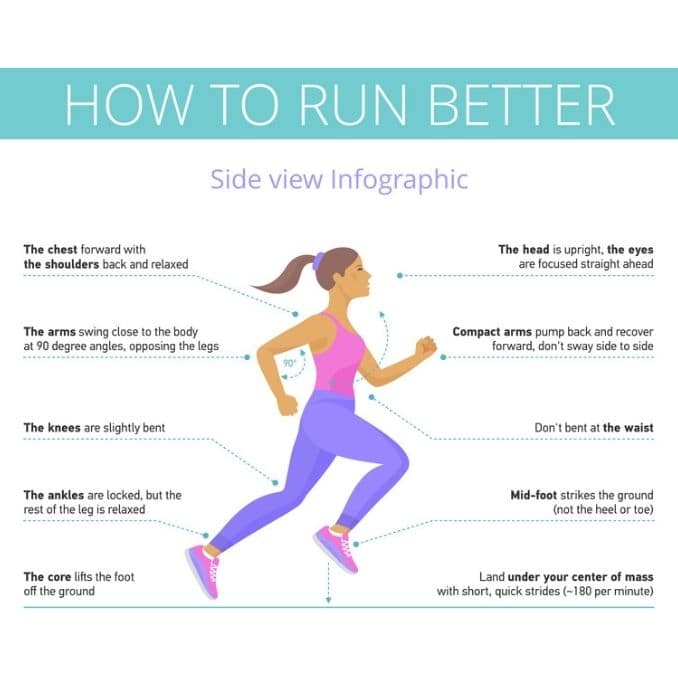
Whether you are a lifelong runner or you are just getting started, you’re probably aware of the challenges you face as an individual over the age of 50.
As you get older, several changes occur that can affect your running routine. It takes longer to heal from muscle tears and other sorts of injuries. Your joints have suffered 50 years of wear and tear and may complain more quickly about pressure and impact. The distances you covered 10 or 20 years ago may now leave you stiff and in pain.
It can be frustrating, and sometimes the pain can be intense enough that you may wonder if your running days are over. Never fear–you can keep running. All you need to do is make a few adjustments to take care of your body and prevent injury.
Why Running After 50 Is Different
First, the good news: running remains a healthy activity, regardless of your age. Research shows that older athletes have more muscle and healthier muscle mass than older people who are sedentary, plus they have healthier hearts and less body fat. They have fewer long-term health conditions, take fewer medications, and have a fewer hospital or medical visits.
The same is true, by the way, of people who come to running late in life as those who have trained most of their lives. One study compared the two and found few differences among the groups. Both had greater muscle mass and less body fat than their sedentary counterparts, though the latecomers’ spines weren’t quite as dense (strong) as those of long-term runners.
Overall, no matter when you start, running helps keep you healthy and younger than what is normal in our society today. But there are concerns. It may hurt more, for example, and you may have heard stories of how might be better off doing something else if you want to save your knees and hips from injury.
Let’s look at a few of the common challenges that older athletes face:
- Decreasing aerobic capacity: As you get older, your body is not as efficient at delivering oxygen to your working muscles. That can result in sore muscles as your body turns to carbohydrates for energy.
- Increasing body fat: Most people put on a few pounds with age. Hormonal changes can play a big role in causing that, no matter how hard you try to avoid it. This changes your overall body composition.
- Shrinking muscles: Starting around 40, you begin to gradually lose muscle. Hormonal changes also make it more difficult for the body to maintain muscle mass. You can counteract this through strict training, but it does create an additional challenge to later-life running.
- Slowing metabolism: Your resting metabolism tends to slow as you age, and even though regular exercise can help, it’s likely that running won’t help you lose weight, for instance, as easily as it did when you were younger.
- Joint wear and tear: After 50+ years working your joints, expect some wear and tear. Running is a high-impact sport, and can be hard on your hips, knees, ankles, and feet. Tending to these changes can help keep your joints working for you rather than against you.
- Injuries are more common: You’ve probably already experienced it—that unexpected injury that sidelined you longer than you wanted. Injuries are more common in older runners and can be frustrating and discouraging.
You may have experienced other changes personally. The point is that things are different now. But that doesn’t mean you have to leave running behind.
How to Keep Running After 50
1. Embrace Strength-Training
Even if you’ve lifted weights on occasion in the past, it’s now critical to your ability to keep running pain-free. The stronger your muscles are, the safer your joints will be. If you don’t address aging’s effect on muscle tissues, function, and output, you’ll be setting yourself up for injury.
Set up two times a week when you can engage in a complete strength session. You may want to work with a certified trainer for help in getting started. Some good options for exercises include:
- Squats
- Step-ups
- Planks
- Overhead lunges
- Single-leg deadlifts
- Push-ups
- Wall sits
- Calf raises
2. Mix It Up
You may have been able to run every day when you were younger, but now it’s time to mix it up with some other types of exercises. There are a few reasons why this is helpful:
- You’ll use other muscles, which will help keep them in balance and reduce the risk of injury.
- You’ll give your running muscles adequate rest.
- You’ll surprise your body, making weight-loss easier.
- You’ll be more likely to enjoy whole-body fitness.
- Cross-training keeps things fresh, so your exercise routines don’t get boring.
Some good potential “mix-it-up” activities include:
- Cycling
- Swimming
- Yoga
- Walking
- Tai chi
- Elliptical machine
- Pilates
- Rowing
- Ice or inline skating
- Cross country skiing
3. Stretch…A Lot…and Learn Yoga
You know you’re supposed to stretch before and after running to stay flexible, but you may have skipped it in the past to save time. Now you simply can’t avoid it anymore. After a short distance of warming up, stop and stretch your calves, hamstrings, quads, ankles, waist, shoulders, and neck. Get everything loosened up before you go any farther and you’ll be less likely to suffer an injury.
Then when you’ve finished running, do the same thing. Take at least 5 minutes to stretch thoroughly in both cases.
Also, you’d be wise to sign up for a yoga class or if you already know the poses, to perform them regularly. Doing a yoga session after a run can help you stretch out and identify any tight spots that may signal future injuries. A yoga routine can also help you catch those muscle areas you may miss in a post-workout stretch.
4. Get Enough Sleep
Everyone needs 7-8 hours of sleep per night for optimal health, but this becomes even more important if you want to keep running into older age. Your body repairs itself while you’re sleeping, so if you don’t get enough, those muscles you challenged will not be able to recover quickly enough.
Sleep can be more difficult with age, so if you’re struggling, look for solutions. Take a warm bath before bed, make sure your room is cool and quiet, invest in a quality mattress, and if the pain is keeping you up, try massage, over-the-counter pain relievers, or natural options like turmeric, white willow bark, and ginger.
5. Pamper Yourself
Your body has served you well for nearly half a century! You’ll experience more comfort and vitality for the next half-century if you treat it well. Some good options include:
- Soak with Epsom salts after a run to help your muscles recover.
- Use heat and ice therapy as needed.
- Eat a healthy diet including plenty of protein.
- Drink plenty of water.
- Wear quality shoes, even when you’re not running.
- Take naps as needed.
6. Commit to “Rest Days”
Older bodies take longer to repair themselves. In your younger days, you may have alternated hard runs with easier runs, but now it’s time to add in some days off of running completely, or at least to add in another easy day. In other words, give yourself two days between hard workouts rather than one, and you’re likely to notice that your muscles are more responsive.
An example of a weekly training schedule may look something like this:
- Day 1: Strength training
- Day 2: Easy run
- Day 3: Rest day
- Day 4: Cross-training activity, perhaps with easy strength-training
- Day 5: Hard run
- Day 6: Rest Day
- Day 7: Long easy run
You can adjust this schedule to make it work for you, but it gives you an example of how to incorporate rest days into your week.
7. Consider Supplements
In addition to eating a healthy diet, you can help preserve muscles and joints by adding in a few dietary supplements. The following can also help preserve joint function, tame inflammation, and maintain bone strength:
- Glucosamine, chondroitin sulfate, and MSM (help support the cartilage in joints)
- Turmeric/curcumin (helps tame inflammation and ease the pain)
- Omega-3 capsules (fish oil or krill oil)
- Vitamin D (for bone health)
- Calcium (better from food, but a low-dose supplement may be wise)
- Magnesium (for muscle health)
- Zinc (helps metabolize energy)
8. Replace Your Shoes
Quality footwear becomes as critical as you age. You may have already noticed increased foot and ankle pain. Invest in a supportive pair of shoes, and don’t be afraid to try several before you find the right ones. Visit a specialty running store and talk to an expert about your needs.
Consider supportive insoles as well. You can see a doctor and get customized ones made, but these are often expensive. There are many quality insoles available now that help to support the proper foot and leg alignment. Then replace your shoes and insoles about every six months or so, depending on how much you’re running.
9. Check Your Running Form
Most of us don’t have the perfect running form. This may not have mattered much when you were younger, but it can start creating pain and injuries as you get older. If you’re struggling to maintain your running routine, check with a movement specialist—usually a physical therapist—to analyze your form and help you make adjustments.
It can also help to follow the basics of good running posture:
- Hold your head up—don’t allow your head to shift forward.
- Keep your hands at waist level and relax your fingers and wrists.
- Keep your shoulders level and relaxed. Don’t hunch.
- Keep your back straight. Think about “running tall.” No slouching! Imagine a string at the top of your head consistently pulling you up.
- Avoid swinging your arms across your chest. Arms should swing back and forth from the shoulder joint, not the elbow joint.
- Avoid “bouncing.” Run lightly and lands softly on your feet. Keep your stride low to the ground.
- Shorten your stride. Take short, light steps that don’t extend too far out from the body. When you want to go faster, focus on driving the leg back from the hips rather than reaching forward with the foot. Shoot for 170 steps per minute if you’re running faster than a 10-minute mile, and about 160 steps per minute if you’re running slower.
- Watch where your foot lands. When it hits the ground, it should be directly in line with the rest of your body. If it’s too far forward, you could have an aggressive heel strike, which can increase the risk of injury and is harder on your joints.
- Try to stay relaxed. Be aware of any tension in your body.
10. Listen To Your Body
Aches, pains, and other problems usually get worse if you ignore them. All athletes should pay attention to these signals, but it’s particularly important for older athletes. Take a rest day, use ice and heat, and try to find out what’s causing the pain. Then work gradually back into your running routine.
Remember, it is never too late to start running, providing you take the proper precautions to ensure your body stays strong and healthy. So, don’t be afraid to put some miles on those running shoes. You might find that running becomes your new favorite activity.
Keep running without pain. Learn how to eliminate Achilles Tendinitis once and for all!
“>












